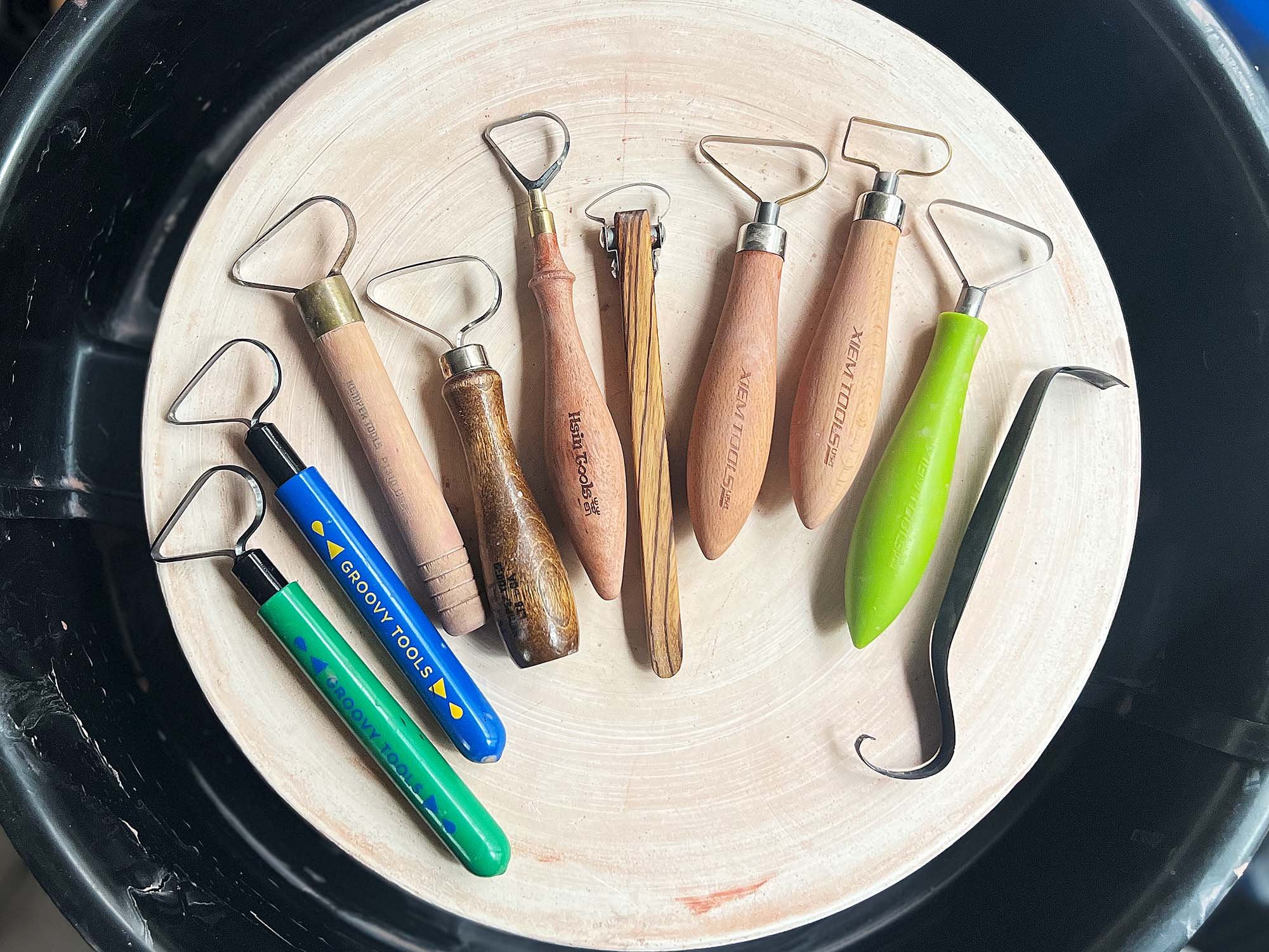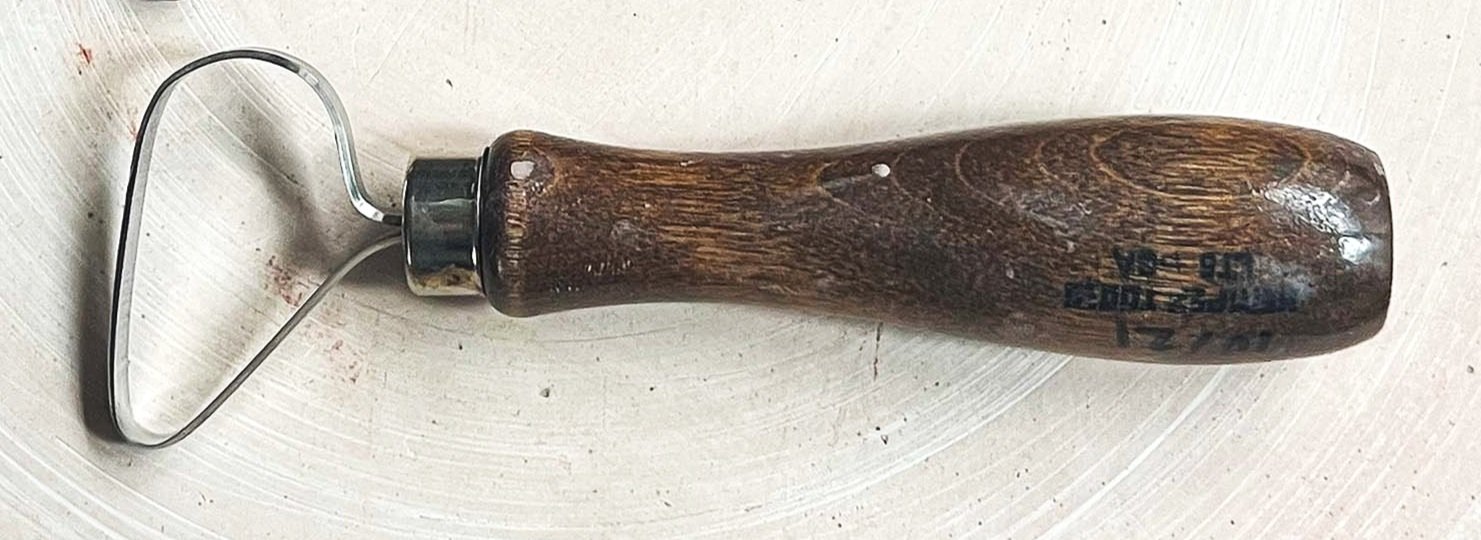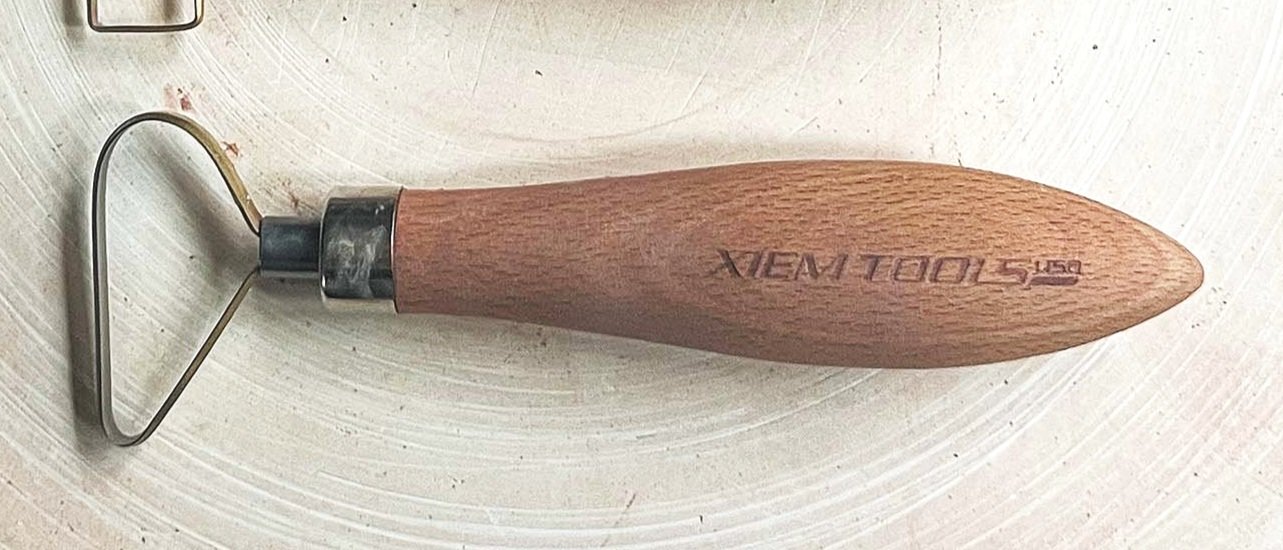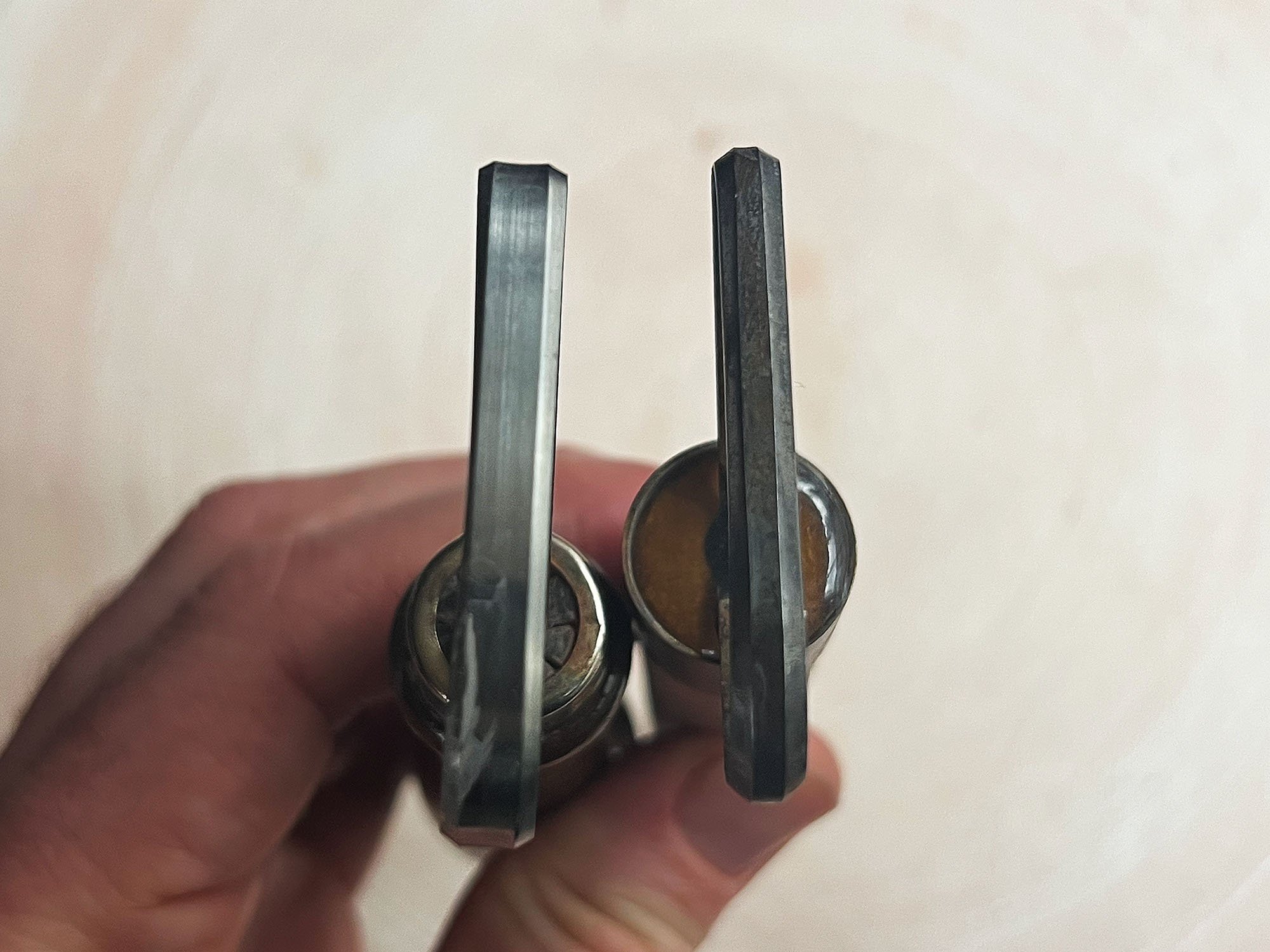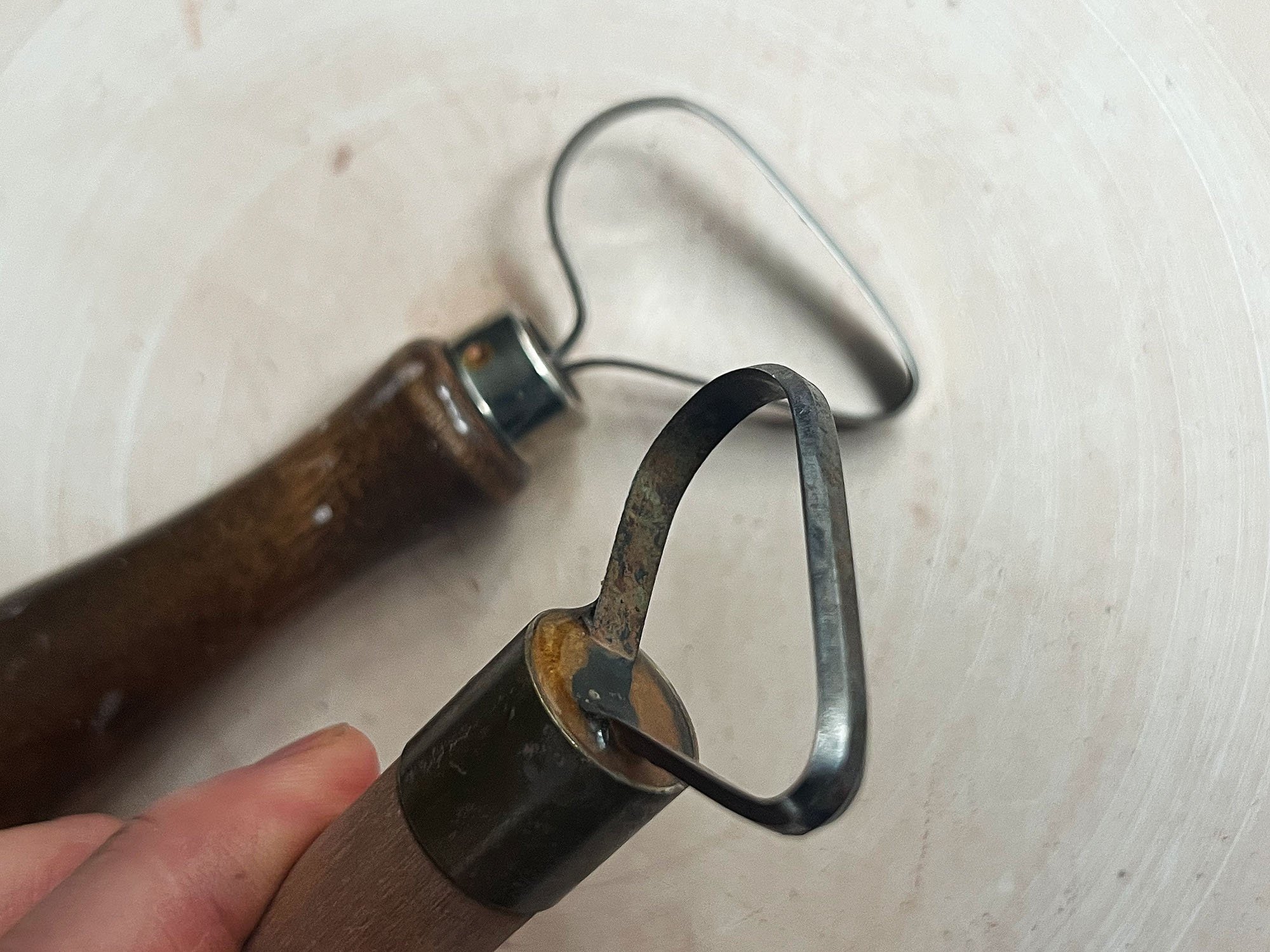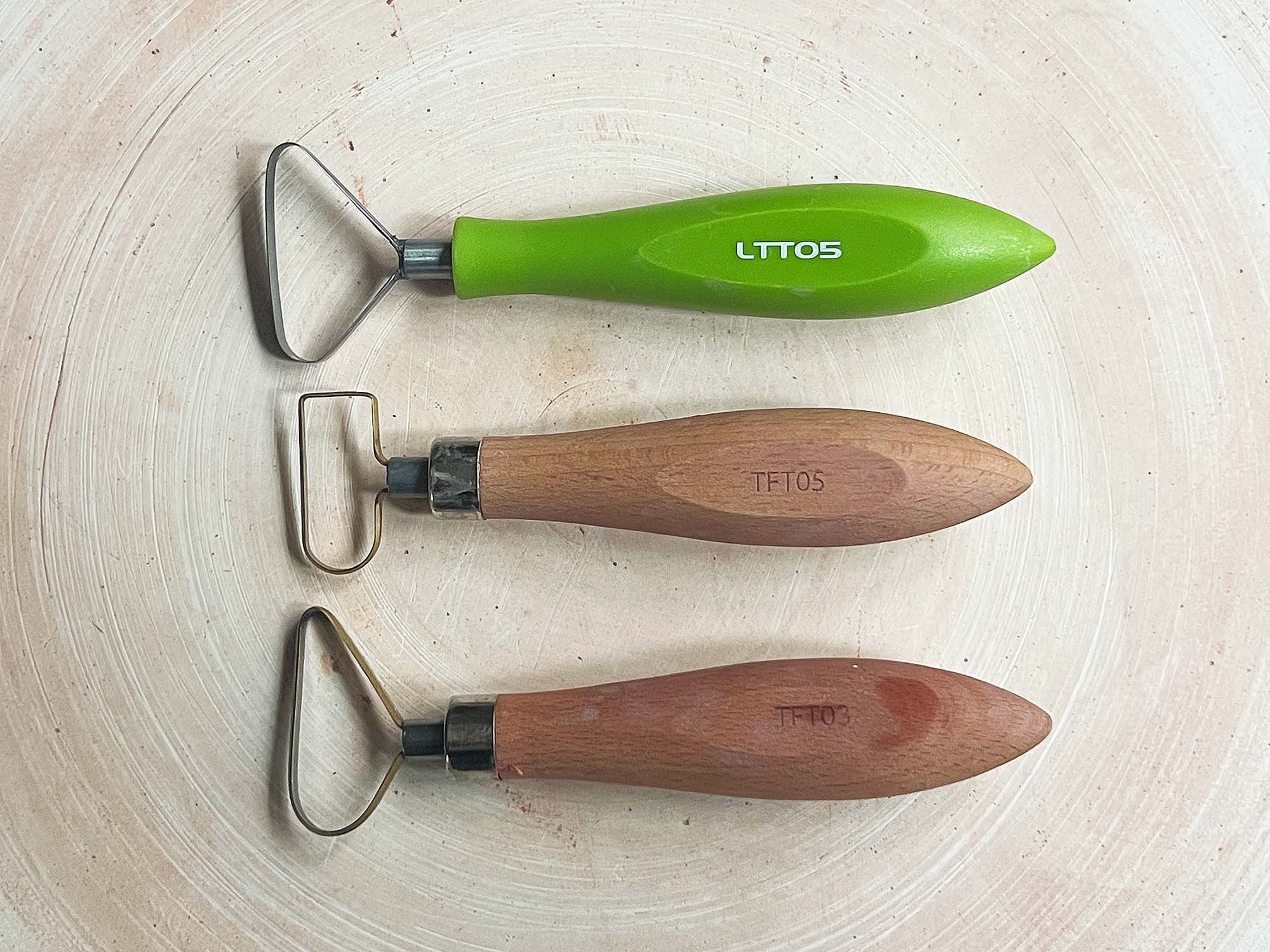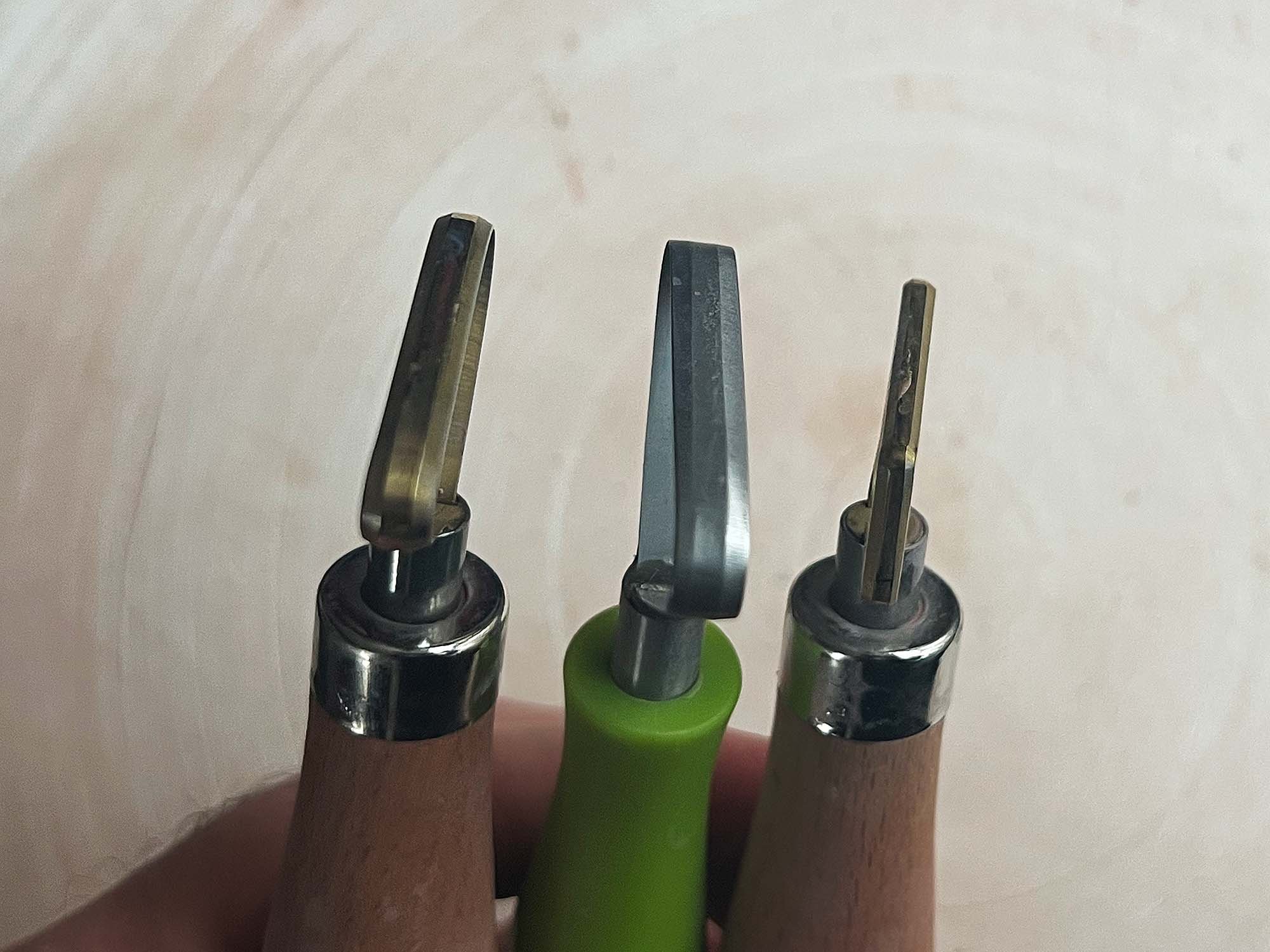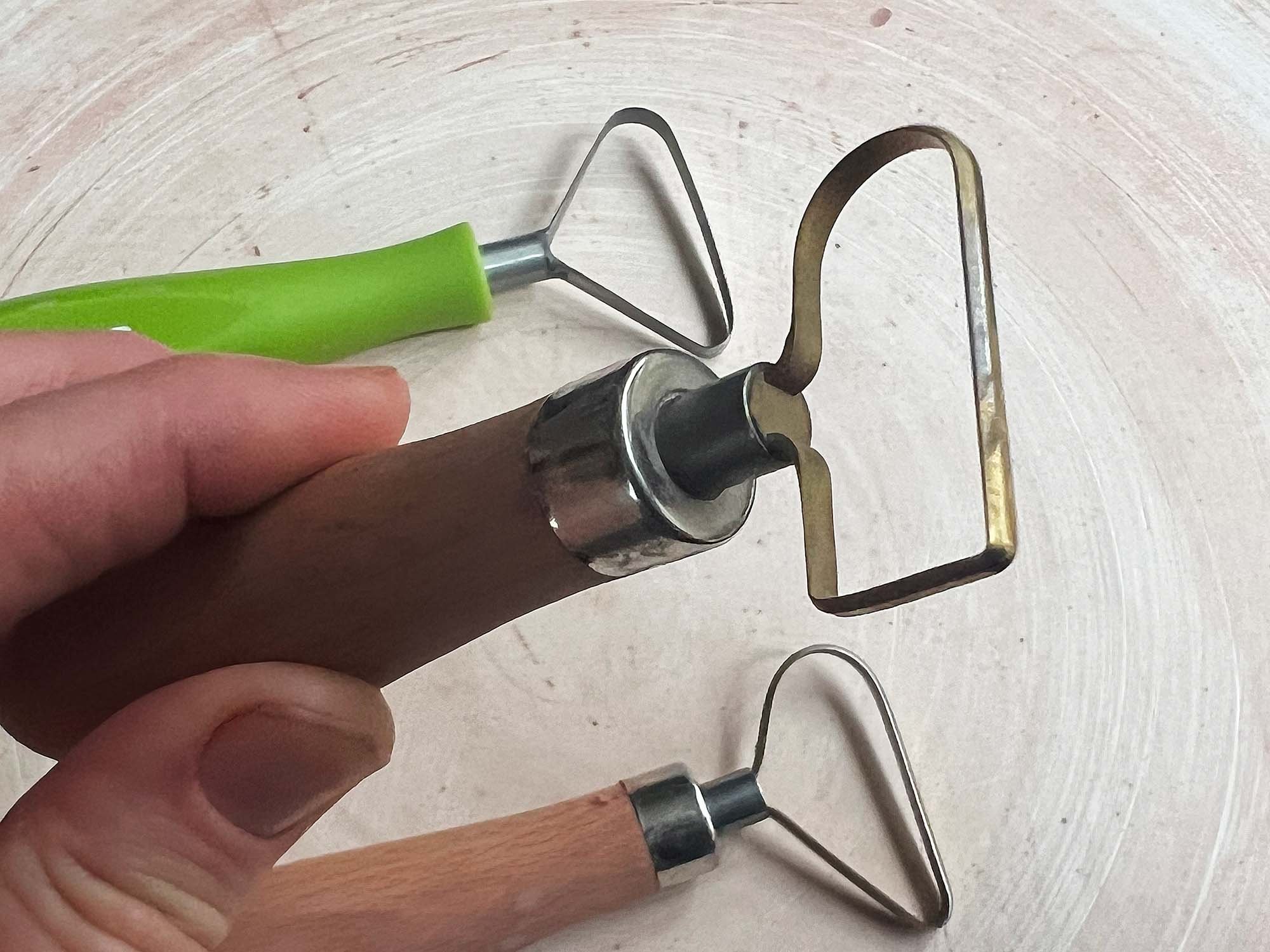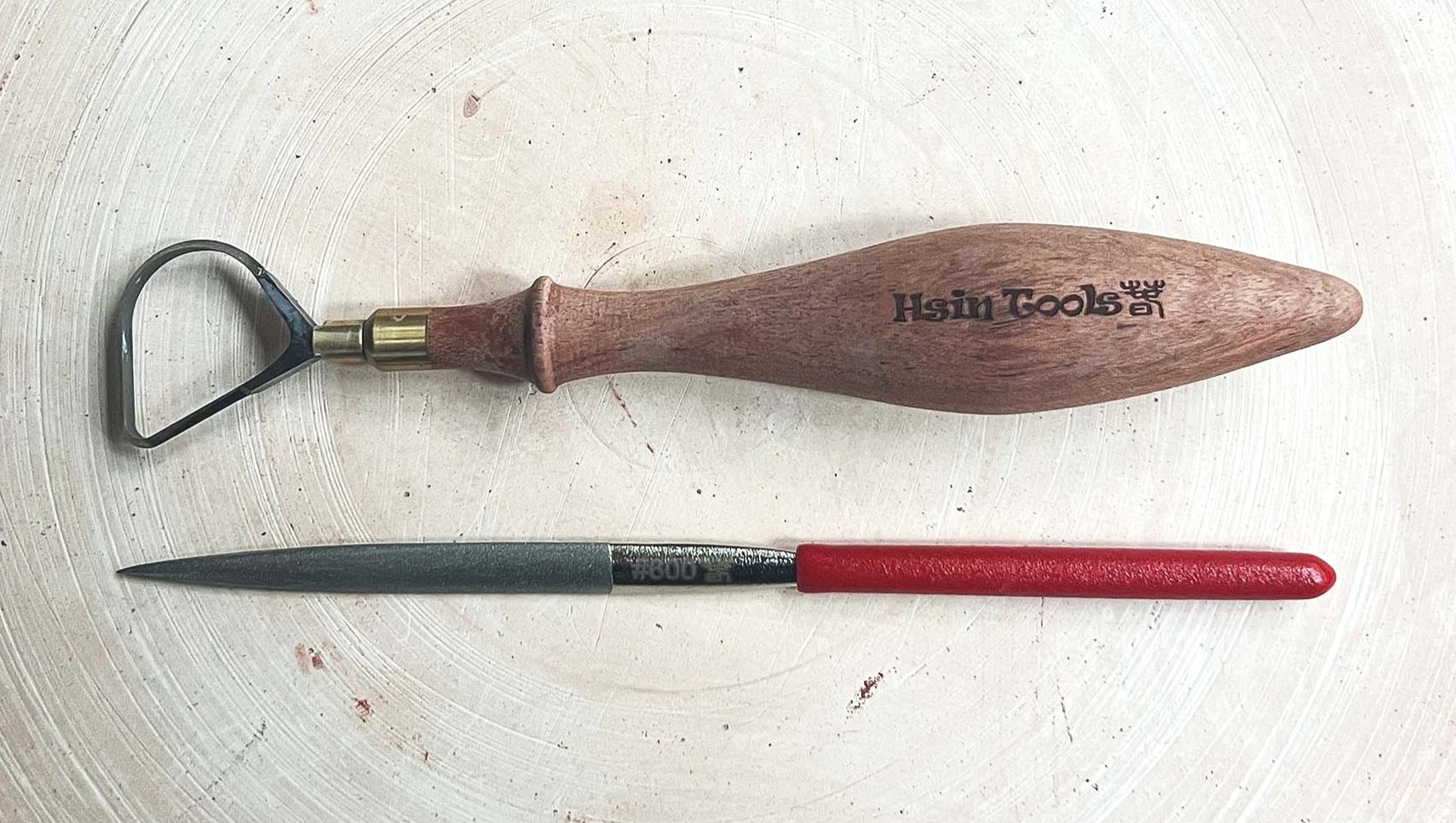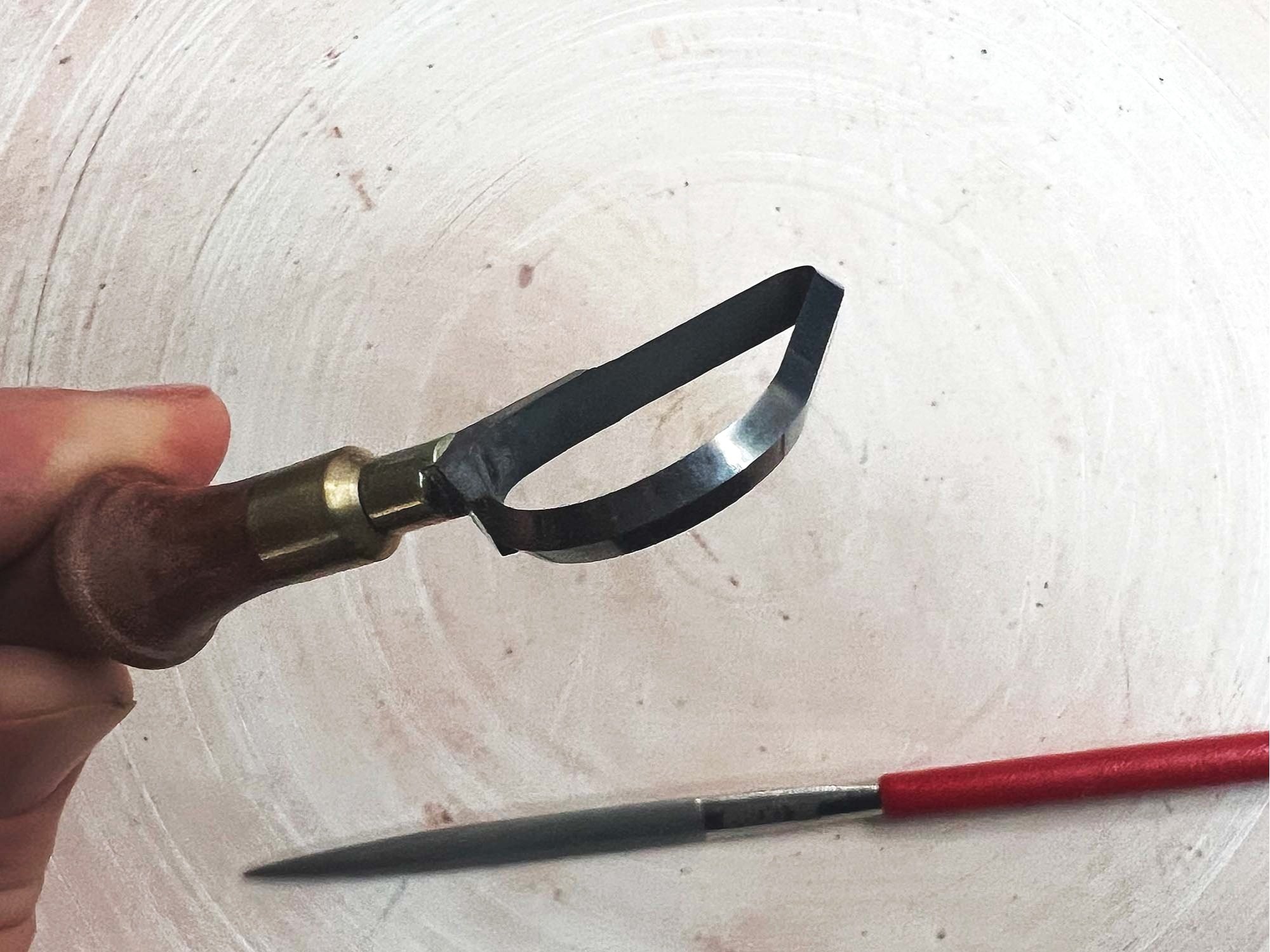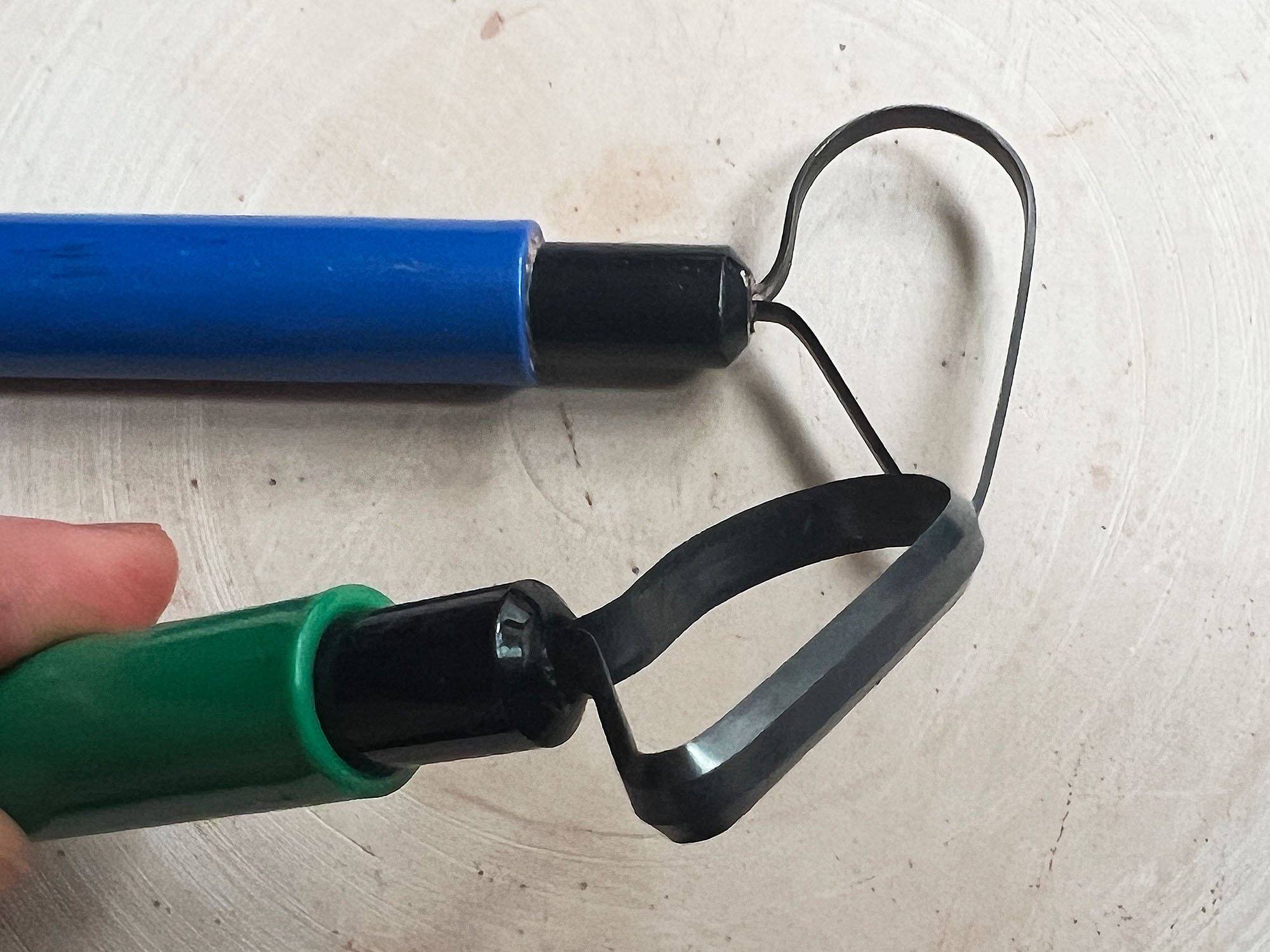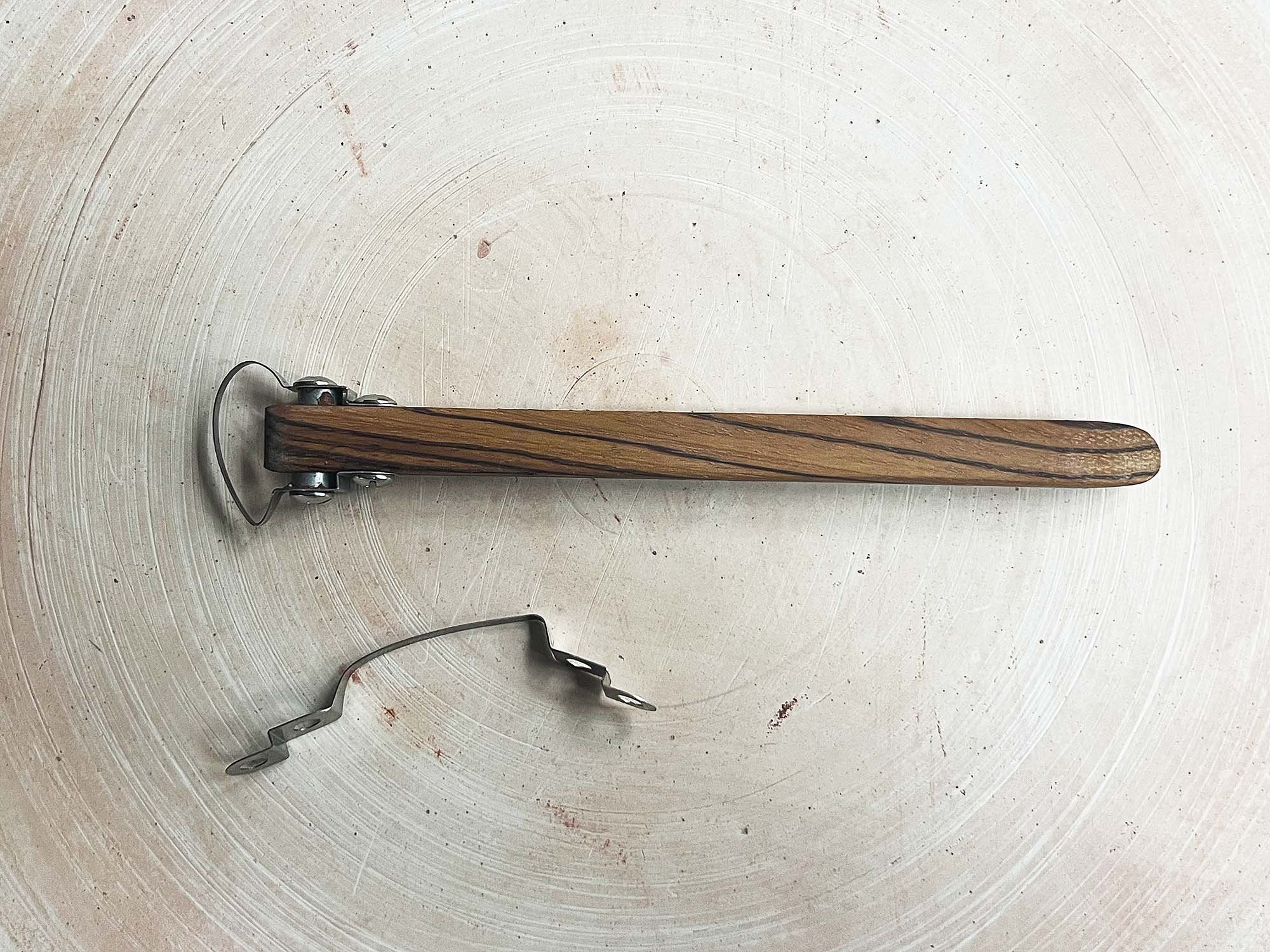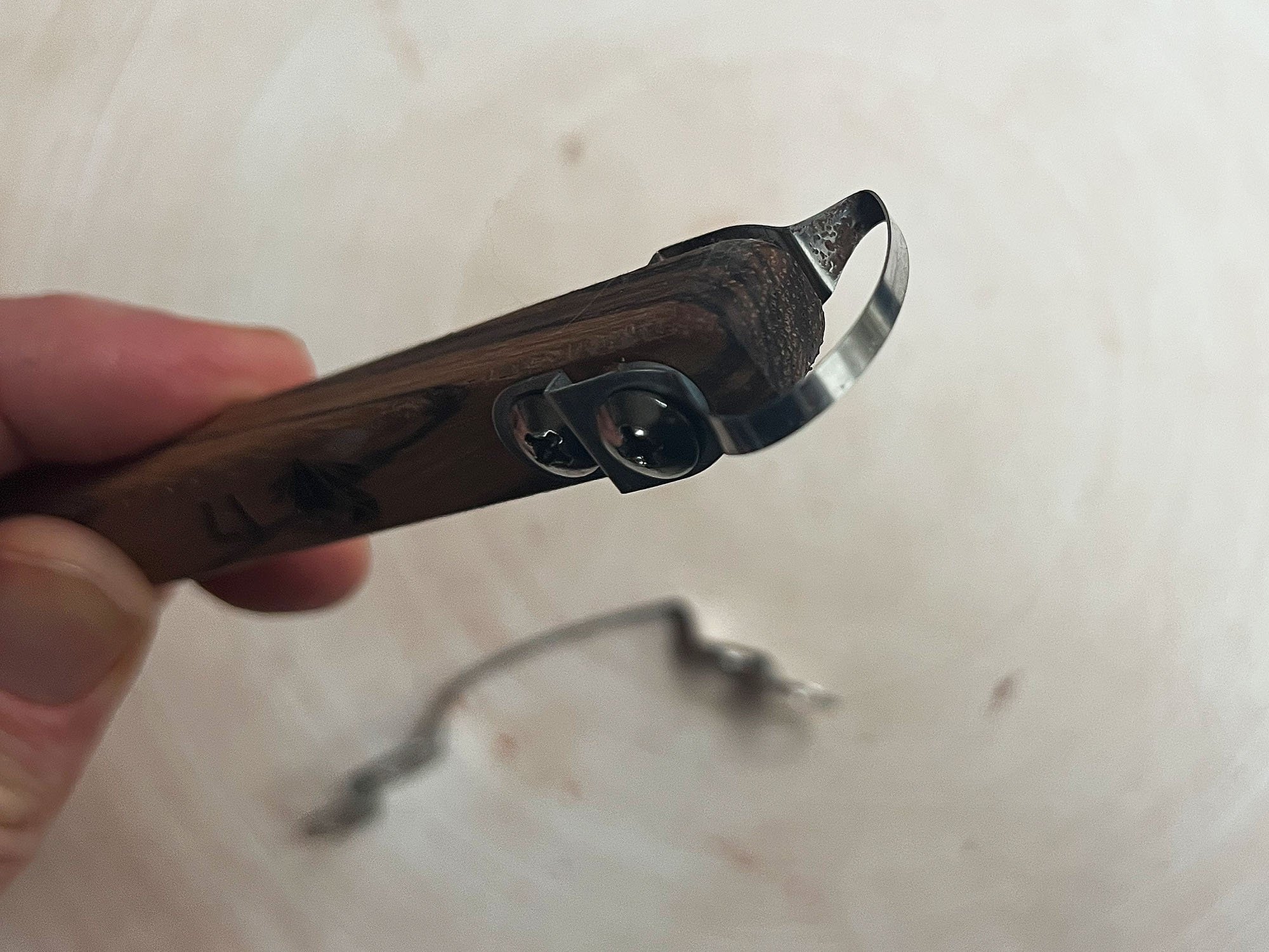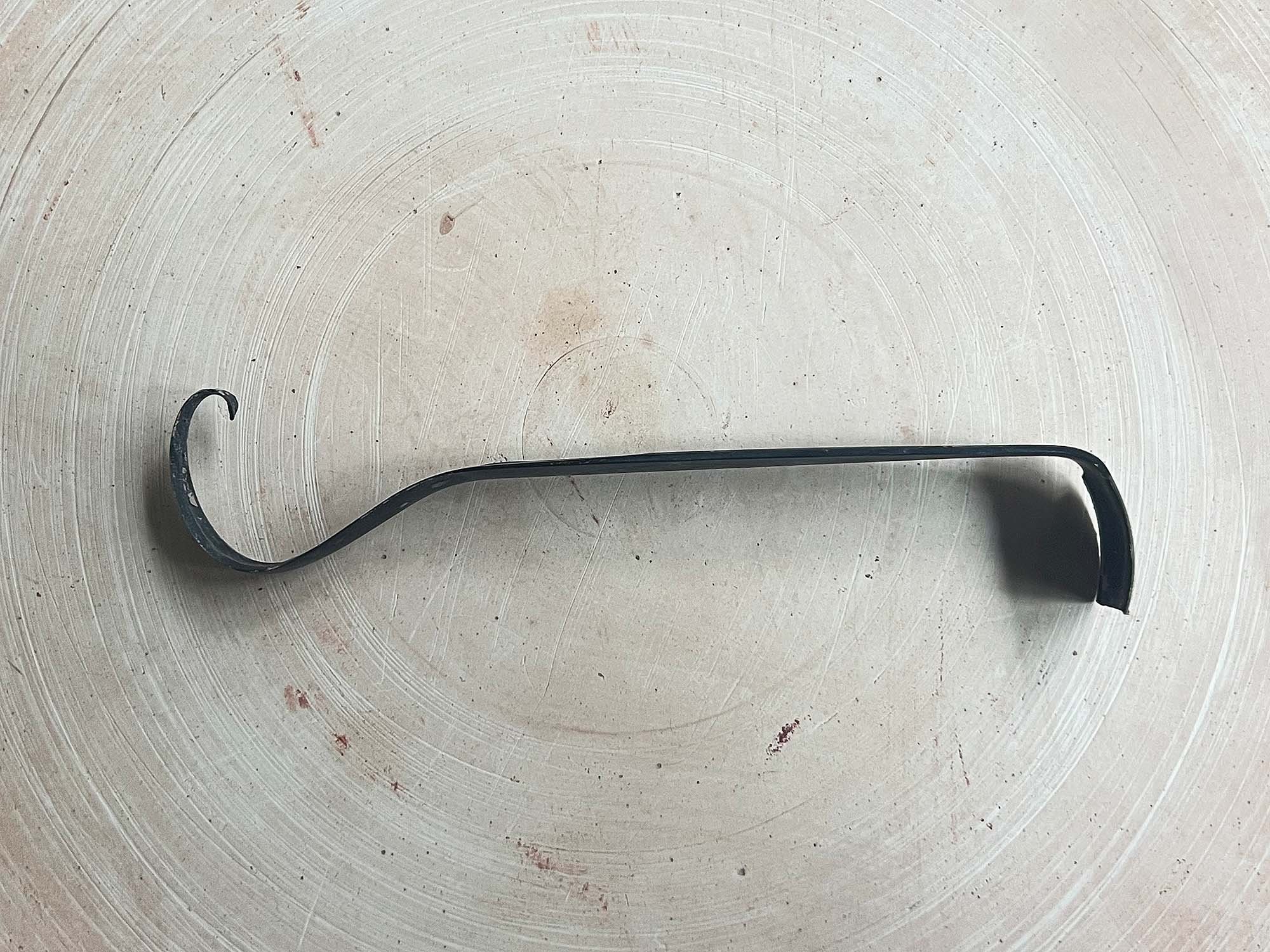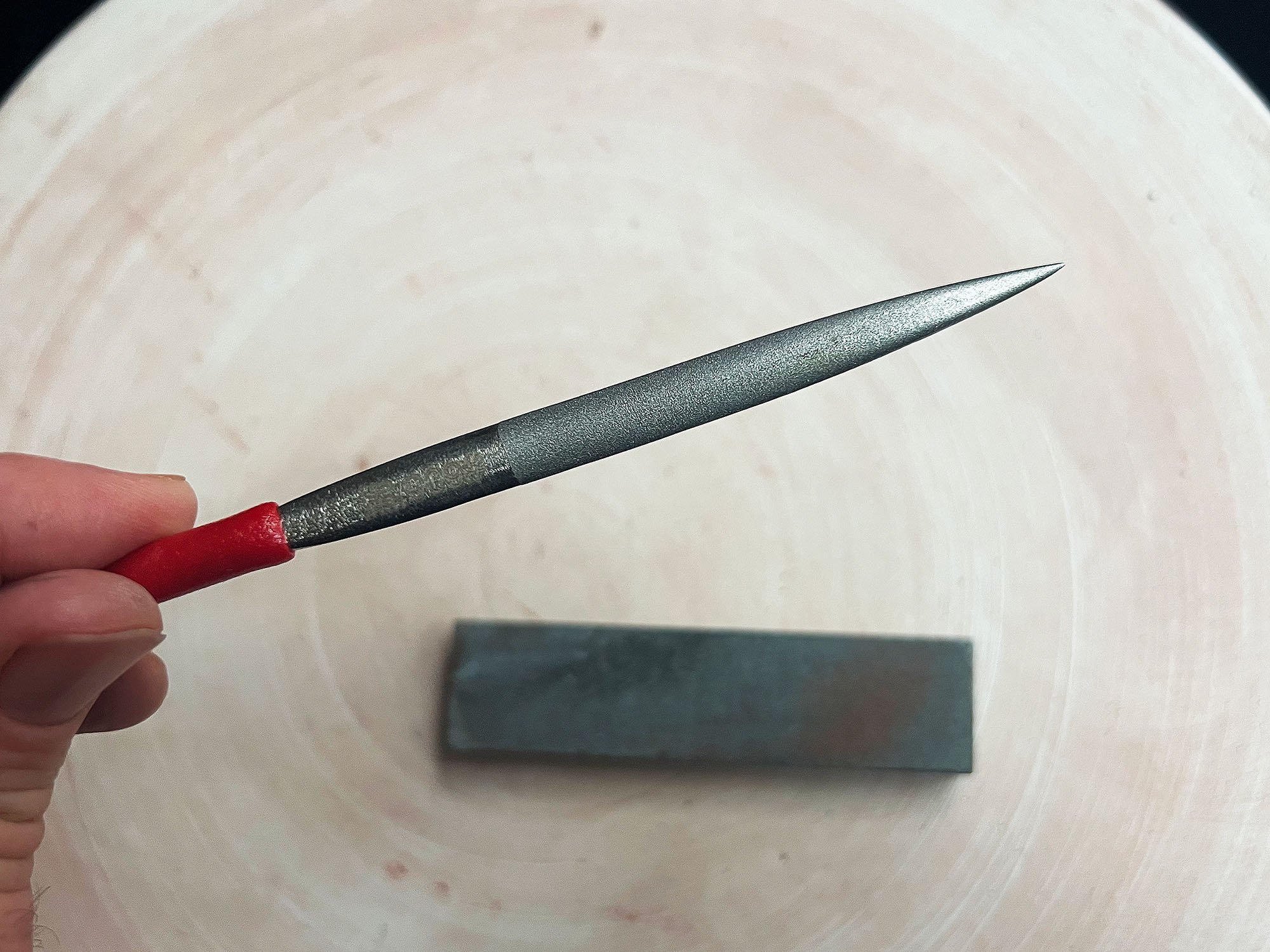For this post, 10 professional-grade loop tools from 6 manufacturers were tested to find the best option for trimming and cleaning up pottery. Considerations included sharpness, comfort while using, durability, and whether the metal in the blade was stiff or more flexible.
Overall, these will all be fine tools for your studio but there were a few favorites including the basic Kemper loop tool and two loop tools from Xiem tools. The drawback for many of these tools was stiffer blades that while they may stay sharp longer, resulted in “chattering” or a slight bouncing while trimming.
Prices for these loop tools range from $4 to over $80 for the specialized tungsten carbide tools. The good news is that you don’t have to spend a lot. Our top picks range from $4 to $18 each.
This test did not include the very cheapest loop tools, such as those that come with light-colored wooden handles found in the budget tool sets. These tools are fine for beginners but the blades wear down very quickly. At the very least, more serious potters should upgrade to the Kemper loop tool (our top pick) or consider starting with the Kemper pottery tool kit. For beginners, also check out our tool guide for pottery beginners.
Every manufacturer makes a large variety of trimming tool shapes, but for the sake of comparison, this test mostly covers “pear shaped” loop tools. If you prefer different shapes, you could find those with the same blades and handles as most of our picks. The conclusion of the post covers some ideas of how to sharpen and maintain your loop tools. All of these tools can be sharpened at least a few times and many are designed to be sharpened over and over.
TOP PICK: Kemper 5” Pear Shaped Loop Tool (* Also the top value / top budget pick!)
The Kemper 5” Pear Shaped Loop Tool. This is also the large loop tool that comes standard in the Kemper Pottery Tool Kit.
After testing, the best option for most studios is the standard Kemper pear-shaped loop tool, which typically retails for $4-$6. This tool combines quality and durability in a very affordable package. It’s available at just about every ceramic supply shop or can be found for just $3.77 at Blick in the United States.
Coming in to this test, this was my default trimming tool, but even after testing all the other loop tools, this is the one I reached for most. The blade stays decently sharp and the metal is soft enough that it doesn’t result in “chattering” or bouncing while trimming. And while the blade does wear down over time, it can be sharpened at least one or two times. For me, these tools typically last 6 to 12 months before I need to replace them. At $4 each, it’s a fantastic deal.
UPGRADE Pick: Xiem Pro TFT #03 Large Teardrop Shaped Loop Tool
The Xiem Tools Pro TFT #03 or large-sized teardrop shaped trimming tool features a blade that is 1.81 inches wide. Shop tool at Etsy.
The Xiem Pro TFT 03 is my top upgrade pick for a loop tool. The tool features a great blade, the tool is very comfortable in hand, and the handle has one side that is slightly flat so that the tool won’t roll away.
The blade is beveled on both sides and is a gold color when it arrives, although this gold wears away with use. The Xiem Pro line are advertised as “titanium-fused” and they claim it is “three times” harder than regular steel with enhanced rust protection. The blade was sharp but it didn’t stay as sharp as the much more expensive tungsten carbide blades. Throughout my testing, I didn’t notice even a hint of rusting with the blade on this tool.
Xiem makes 3 teardrop-shaped trimming tools, with blades that are about 1 inch, 1.4 inch, or 1.81 inches wide and they cost $17, $18, or $19 each. These tools felt most similar to the Kemper Pro line of tools, but I feel that the quality of the blade and distinctive handle makes them the superior pick versus the Kemper Pro tools.
ALSO GREAT: Xiem Tools Pro Multi-function Loop Trimming Tool
The Xiem Tools Pro Multi-Function Loop Tool TFT05 has a blade that is about 1.4 inches wide and is available at Etsy.
I wasn’t familiar with these tools before this test, but this distinctive style from Xiem Tools quickly became my favorite detail trimmer. As in the the other Xiem Tools Pro Trimmers, the Multi-Function tools feature a titanium-bonded steel blade and ergonomic handle with a flat bottom.
Where this tool really shines is its versatility and distinctive shape. You can trim broad areas, slight curves, or create a nice right angle on a foot ring or other part of your ware. The multi-function tools have a thinner blade, so they may not be the greatest for your first few passes in trimming, but they are great for detail work.
The blade is beveled on two sides, and is also golden color when new, although that wears off with use. The tool is advertised as being rust-resistant and it stayed rust free throughout the months of testing.
These tools are available with blades that are about .9, 1.4, and 1.9 inches wide, and cost $17, $18, or $19 each. I liked the medium so much that I went ahead and ordered the other two.
For the complete review of every tool tested, keep reading below.
Table of Contents
Top Picks
How Loop Tools Were Tested
Kemper and Kemper Pro Loop Tools
Xiem and Xiem Pro Loop Tools
Hsin Tools
Groovy Tools Loop Tools
Diamond Core Loop Tools
MudTools Do All Trim Tool
Sharpening Stones and Tools for Ceramic Tools
Summary
How the Loop Tools Were Tested
For this test, every readily available loop tool on the market was purchased. When multiple sizes were present, such as the Xiem Pro line, the medium option was selected so that tools could be compared on a one-to-one basis with relatively similar sizes. Because they were harder to find, Buffalo Pottery Trimming Tools and the Dolan Tools were not tested. (Dolan Tools appear to be unavailable however, it appears that the Kemper Pro line are the exact same tools.)
My own personal biases and preferences also come in to play with this test, so I’ll share that information here: For years, I only used the basic Kemper pear-shaped loop tool and that shape and style of metal just feels “natural” to me. And though I have tried the open-ended L-shaped trimming tools, they have never been something I used regularly and so I am leaving those tools for a future test.
Finally, if you have a loop or trimming tool that feels good to you, that is probably the best thing to keep using as we all have different styles of using these tools.
Kemper and Kemper Pro Loop Trimming Tools
The Kemper Pro PT310 Loop Tool at top, and the standard Kemper Pear-Shaped Loop Tool at bottom.
Two styles of Kemper loop tools were tested, including the basic Kemper pear-shaped loop tool, and the Kemper Pro PT310 loop tool.
As detailed above, the basic Kemper pear-shaped loop tool is our top pick for its combination of quality, durability, and affordability. It’s often available for $4 or less such as at Blick in the US.
The Kemper Pro line feature thicker blades that are beveled on both sides, and a straight handle. The Pro blade is thicker but not quite as wide as the standard tool, and can be sharpened numerous times. While stiffer, the Pro blade is still forgiving enough that it didn’t result in any chattering in use. The steel blade is somewhat prone to rusting but if you clean your tools after use, this should be a long-lasting tool.
The standard Kemper loop tool typically retails for $4-6 and the Pro tools are available at ceramic supply shops for around $15.
The Kemper standard loop tool at left (it’s worn down after about a year of use) and the Kemper Pro blade at right.
A detail shot of the Kemper Pro PT310 blade. The steel blade is slightly prone to rusting, but it can be sharpened, cleaned, and oiled for years of use.
Kemper and Kemper Pro Trimming Tools
A wide variety of shapes are available with similar blades but tested here were:
Kemper Standard Pear-Shaped Loop Tool $4-6
Kemper Pro PT310 Loop Tool: $15
Xiem and Xiem Pro Loop Trimming Tools
Top view of the three Xiem Tools trimming tools tested.
Three styles of Xiem loop tools were tested, including the basic LTT05 with a green plastic handle, the TFT05 Multi-Function Loop Tool, and the TFT03 Pear-Shaped Loop Tool. As detailed above, the Xiem Tools Pro line models were definite favorites for their combination of durability, and ergonomic handles. All three Xiem Tools tested feature a flat bottom, so the tool won’t roll away. It’s a nice feature that doesn’t take anything away from the ergonomic, pleasant feel of holding these tools.
The Xiem Tools all have a flat bottom, which is nice feature to keep your tools from rolling away.
The Xiem Loop Trimming Tool or LTT05 tested was a fine trimming tool with a very flat but wide blade with a slight bevel on both sides, and a plastic handle. After a few uses, it wasn’t a tool that I instinctively reached for, and at $15, it’s quite a bit more expensive than the standard Kemper tool. The tool features a blade that is 1.6 inches wide.
I won’t restate everything mentioned above about the Xiem Pro line of trimming tools, but these were definite favorites that I will be ordering more of. They have a great combination of durability, ease of use, quality of materials, and a decent price that is competitive with all the other “professional” loop tools out there.
Close up of the three tools. From left is the Xiem Pro Loop Tool, the Xiem Standard loop tool, and at right is the Xiem Multi-Function Loop Tool.
The Xiem Tools medium sized Multifunction Titatanium Fused Pro Trimming Tool. Shop this style at Etsy.
The Xiem Tools Pro TFT03 pear-shaped trimming tool. Shop this style at Etsy.
The Xiem “standard” Loop Trimming Tool or LTT05. Shop this style at Etsy.
Xiem Tools Trimming Tools
A wide variety of shapes and styles are available. Tested here were:
LTT05 Trimming Tool: $15
TFT03 Teardrop or Pear-Shaped Loop Tool: $18
TFT05 Multi-function trimming tool: $18
Hsin Tools Trimming Tools
The Hsin Tools tungsten carbide loop tools feature a super-sharp, replaceable tungsten blade and also come with a sharpening tool.
Hsin Tools are designed by potter Hsin-Chuen Lin (You may have seen his many YouTube videos) and the loop tools all feature super-stiff tungsten carbide trimming blades with beautiful wooden handles. The pear shaped tool tested is not cheap—the current price is $88—but the blade is replaceable and they are definitely the nicest looking loop tool tested. It also comes with a sharpening tool so that you can keep it as sharp as possible.
The loop tool features a straight bevel on both side, making it easy to sharpen and maintain.
As a trimming tool, I found it comfortable to hold and although the loop opening was smaller than other tools, it worked fine for a wide variety of trimming purposes. The blade itself has a nice thickness and angle and stayed extremely sharp throughout testing. And although the finish on the handle seemed to fade quickly with clean up, they can be oiled as needed to bring back their shine.
The drawback to this tool (in addition to the price) is that the stiff tungsten material is prone to chattering. As much as I wanted to love this beautiful tool, after a few uses I just didn’t reach for it because I knew that somehow every pot I trimmed would end up with chattering marks. This might be me—I do prefer softer trimming tool metal—but I just didn’t connect with this tool even though I wanted to love it.
Hsin Tools Loop Tools
Available in pear shape or square shape. $80-$88 each
Replacement blades available for $60
Groovy Tools Loop Tools
Groovy Tools Trimming Tools. At top is the thinner 301 model. At bottom in green is the thicker 205 model.
Groovy Tools are an interesting entry in the loop tools category because of their plastic handles and hardened and tempered blades. Made by Kentucky Mudworks, the tools can be resharpened for a long life and are are available in a variety of shapes. For this test, the pear-shape tool from the 200 and 300 series were tested.
The 200 series has a thicker blade and the 300 series is slightly thinner. In practice, both could be used for a wide variety of trimming tasks and I would consider the thinner 300 series to be a “normal” thickness while the 200 series is beefier, and might be great for sculpting or use with rough clays.
The thinner 300 series is at left, and 200 series at right.
The blades feature a flat edge and bevels on both side. In practice, they felt very similar to the Kemper pro line of trimming tools. As with other harder / stiffer blades, I had problems with chattering with these tools and while I kind of like that they have plastic handles (easy to clean!) the stiffness of the blade was a drawback for me.
This line of tools has a wide variety of shapes so it might be worth taking a look to see if something works for you.
A close up of the 200 series blade.
Groovy Tools Loop Tools
$15-$17 each
Available at ceramic supply stores or directly from Kentucky Mudworks.
DiamondCore Trimming Tools
The DiamondCore T7 Avocado shaped trimming tool comes with one replacement blade.
DiamondCore is a beloved brand of ceramic tools out of San Diego, California. In addition to diamond sharpening pads, the company makes stylus tools for sgraffito, fluting and carving tools, and a variety of trimming tools. The T7 avocado shaped tool was tested although since ordering this product, DiamondCore has rolled out some larger sizes of trimming tools. I assume those larger tools feature the same sort of blade material tested here.
The blade of the tool. I found the opening to be quite small on the T7.
The Diamond Core T7 tool features a rather small blade that is attached to the squared wooden handle with 4 screws. The tool arrived with one replacement blade and more blades can be ordered as needed. The blade is thin, sharp, and basically flat. I think it could be sharpened a few times but I would expect it to wear down under heavy use.
I didn’t try unscrewing the blade, but I imagine it would be a simple task and this feature definitely makes this the most environmentally sound tool tested. A used-up blade could be recycled and the handle can be reused indefinitely.
I did find the blade opening to be quite small. This was fine for detail work, but it wouldn’t be the tool I reach for on a first pass of trimming a bowl or other larger ware. And while the blade attachment is great for the longevity of the tool and replacing blades, it was easy for clay to get gummed up and stuck around the screws and bottom of the blade. I’d only recommend using this for trimming quite dry pieces, so that clay doesn’t get stuck.
At $48, this was one of the more expensive tools tested. Yes, you are getting a beautiful handle and the ability to replace blades easily, but unless DiamondCore makes a larger model around 1.4 or 1.5 inches wide, I wouldn’t recommend this trimming tool except for detail work.
DiamondCore T7 Trimming Tool
$48 at DiamondCoreTools.com
Mudtools Do-All Tool
The MudTools Do-All Tool is a carbon steel trimming tool.
The Mudtools Do-All Tool is slightly different from the other tools tested, but because it has one curved end, I thought it would be a good comparison. The tool features two sides. The “L” or “spade” side is beveled on the 3 exposed sides, and the curved or hooked side features a double bevel similar to a teardrop or pear-shaped loop tool.
The tool is made from carbon steel and can be sharpened. The middle handle of the tool is slightly beveled for ease of use and the metal appears to be finished with a matte paint.
The “L” shape or “spade” side of the tool.
It’s a comfortable tool that is really versatile but as mentioned above, I have never really connected with L-shaped tool and as much as I want to love this for the variety of shapes and trimming angles you can take with it, I’m not sure it’s the right tool for most. Personally, I’m just more comfortable with a standard loop tool with a nice chunky handle. But, this is a really interesting option and might be right for your tool kit.
MudTools Do All Trim Tool
$27
The curved or hooked side is somewhat similar to a teardrop shaped loop tool.
Sharpening Tools
Almost every tool in your ceramics tool kit can be sharpened and loop tools are no exception. Standard loop tools can be sharpened a few times and professional-grade loop tools with thicker blades can be sharpened numerous times.
Pictured here are a few options, including the sharpening tool that comes with the Hsin Tools, a small 4 inch long whetstone, and a small motorized whetstone.
Close up on the small whetstone. I use this for polishing the bottom of pots as well as sharpening tools.
Similar to sharpening knives, loop tools can be sharpened with repeated passes of a whetstone, while taking care to keep the bevel even.
Some choose to use motorized bench grinders or whetstones to sharpen their tools but this may be overkill. Some of the softer blades, such as the Kemper standard or basic Xiem loop tool, will get chewed up by a motorized tool.
As with any tool, you’ll have to balance the time and effort to sharpen tools versus the cost of replacing. With the professional grade tools, it is definitely worth it to get a small whetstone and at least try sharpening them. Once you start paying attention to your blades, you’ll notice how you get slightly different results with sharp or dull blades.
Top: the sharpening tool that comes with the Hsin tools tungsten carbide loop tool. Bottom: A 4-inch long backpacking style small whetstone.
The Hsin tools sharpening tool.
A motorized whetstone system, available for $140 at Amazon.
Summary
A wide variety of trimming tools were tested, with a focus on finding the best standard or teardrop shaped loop tool. Top picks included the Kemper standard pear-shaped loop tool, along with the Xiem Pro TFT03 loop tool and the Xiem Pro TFT05 Multi-function loop tool. Most of these tools are available in a variety of other shapes as well, but with the same handles and blades, so it is worth shopping around to find what is right for you.
What is your favorite trimming tool? Let us know in the comments.
